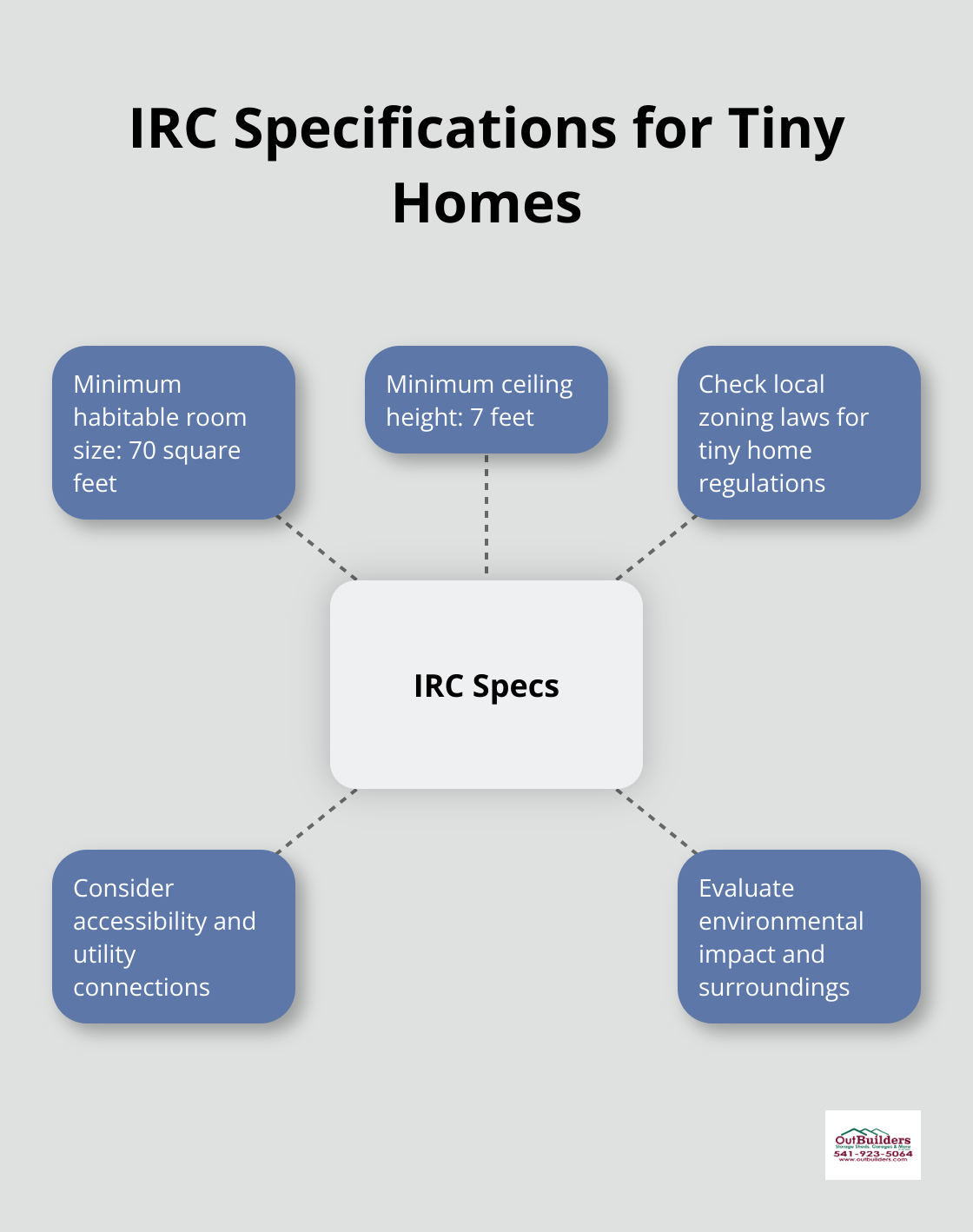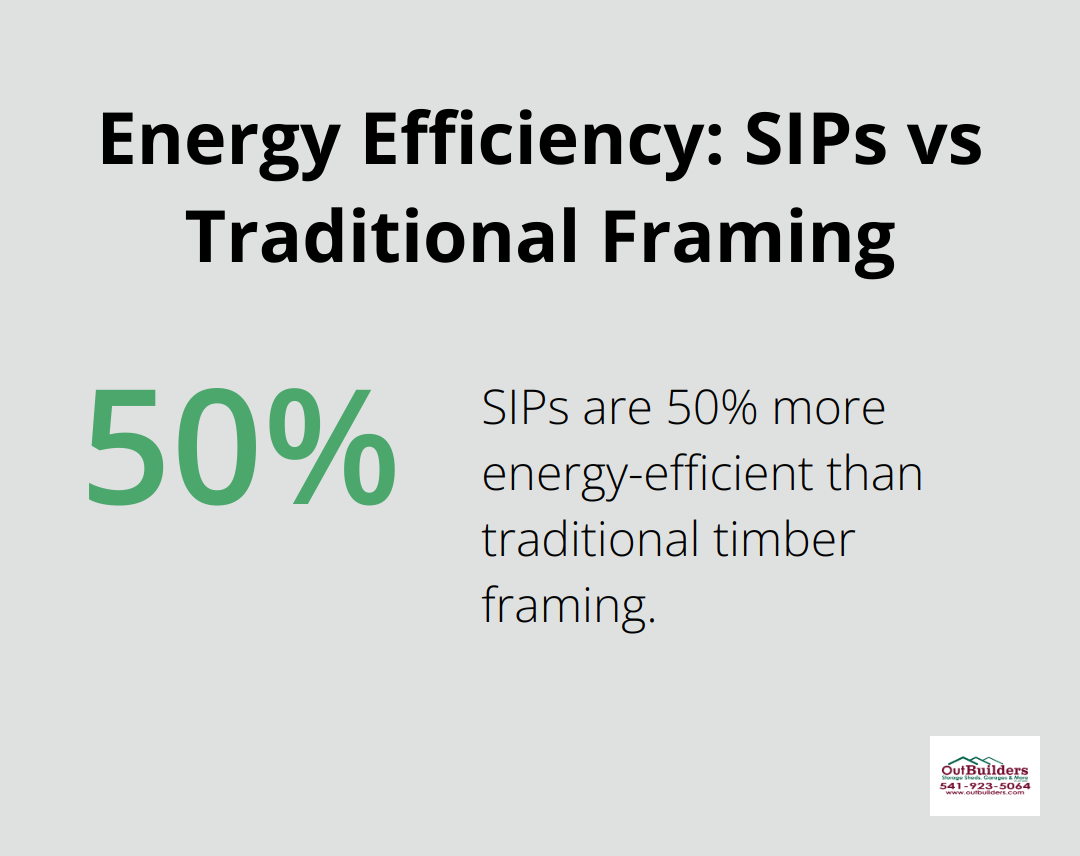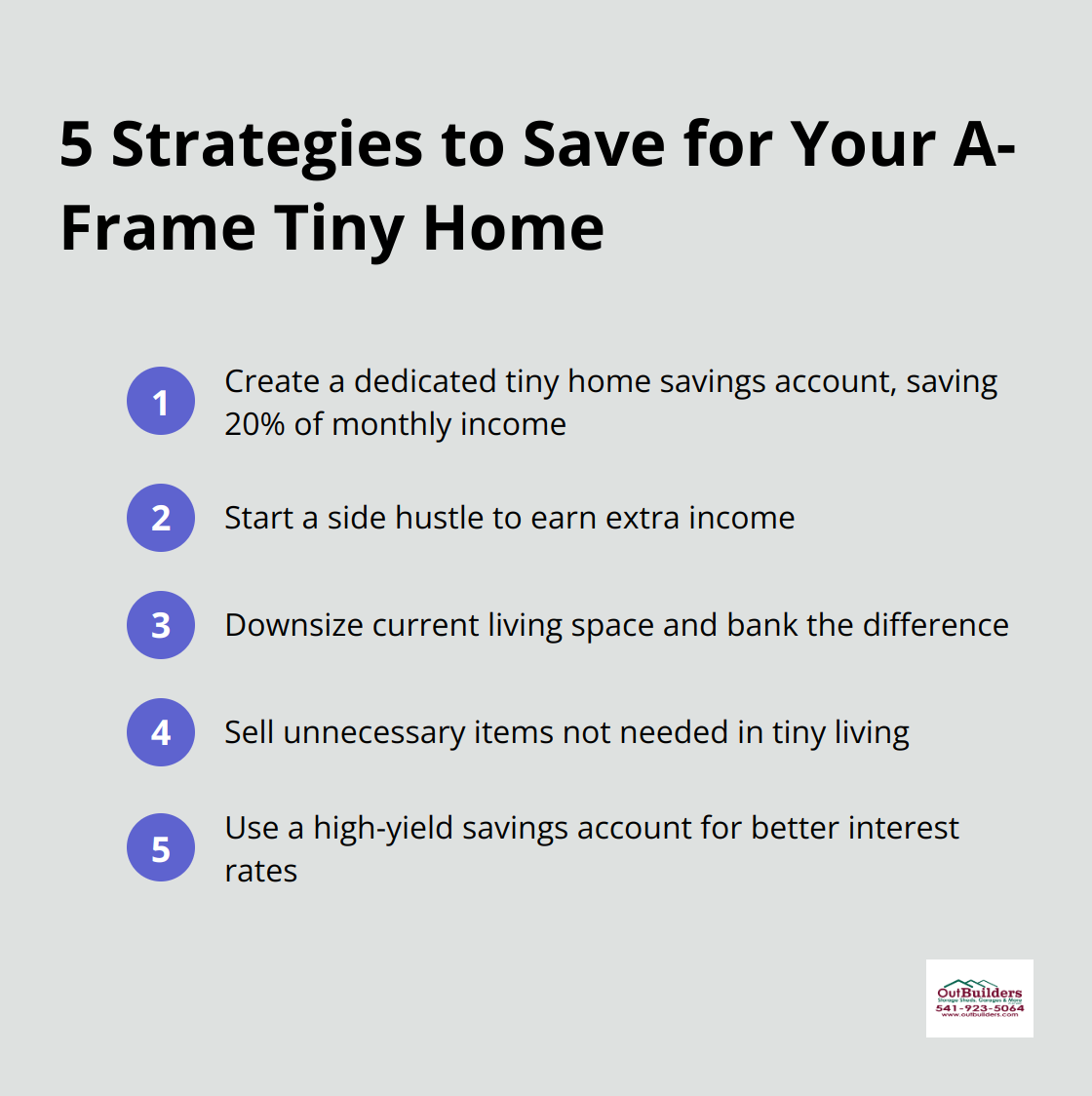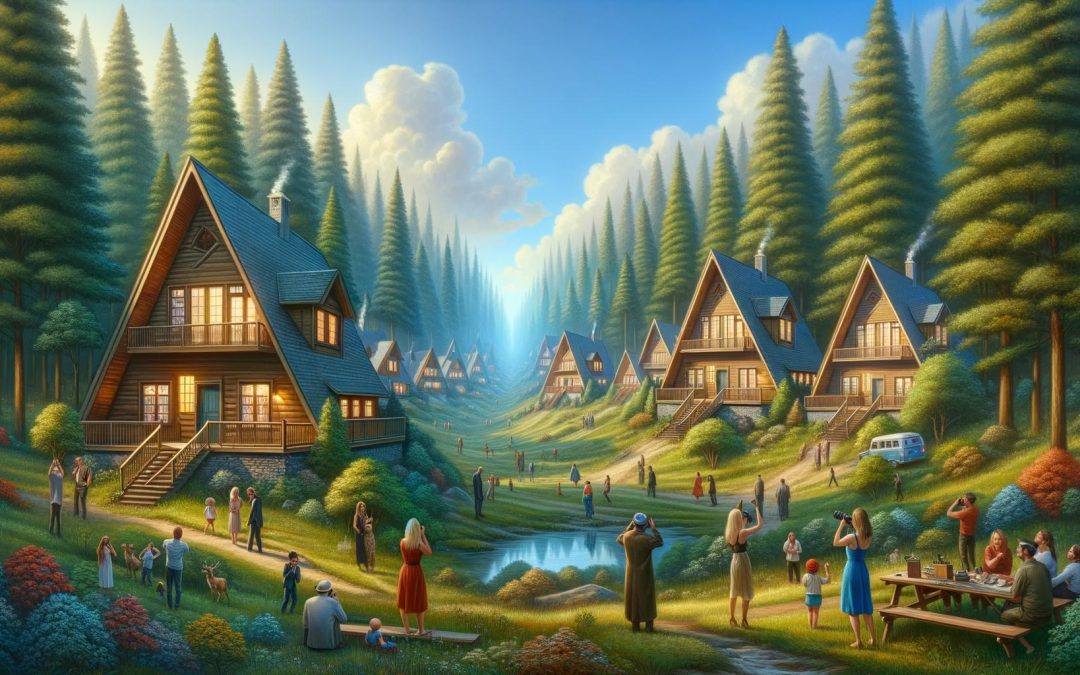A-frame tiny homes are capturing the hearts of minimalists and adventure-seekers alike. At Outbuilders, we’ve seen a surge in interest for these charming, compact dwellings that offer a unique blend of style and functionality.
If you’re on the hunt for an A-frame tiny home for sale, you’re in for an exciting journey. This guide will walk you through the key considerations, from finding the perfect location to securing financing for your dream tiny home.
Where Should You Build Your A-Frame Tiny Home?
Navigating Zoning Laws and Building Codes
The first step in your A-frame tiny home journey is to understand local zoning laws and building codes. Many areas have minimum square footage requirements that don’t accommodate tiny homes. For instance, the International Residential Code (IRC) specifies that habitable rooms should be no smaller than 70 square feet, with a minimum ceiling height of 7 feet. Some regions even prohibit permanent tiny homes altogether. Contact your local planning department to learn about the regulations. You might need to search for areas zoned for recreational vehicles or mobile homes.

The Importance of Accessibility and Utilities
Access to your property is essential. Think about how you’ll reach your home in all seasons. Will the roads remain passable in winter or during heavy rains?
Utilities are another critical factor. Some areas lack access to public water or sewage systems. You’ll need to include the costs of drilling a well or installing a septic system in your budget. For electricity, off-grid solutions like solar panels are an option, but make sure the area receives enough sunlight year-round.
Embracing Nature: Views and Surroundings
A-frame homes excel at connecting with nature. Search for a location that offers the views and surroundings you desire (forest, lakeside, or mountain vista). The large windows typical in A-frame designs will showcase your surroundings, so choose carefully.
Consider the climate too. A-frames handle snow well due to their steep roofs, but they might not suit extremely hot climates. Reflect on how the location will affect your comfort and energy usage throughout the year.
Don’t overlook the community aspect. Even if you seek solitude, having amenities and neighbors within a reasonable distance can prove beneficial. It’s about striking the right balance between isolation and convenience.
Environmental Considerations
The environmental impact of your A-frame tiny home is worth considering. Look for locations that allow you to minimize your ecological footprint. This might include areas with good solar exposure for renewable energy, or places where you can implement rainwater harvesting systems.
Also, consider the local flora and fauna. You want to ensure your presence doesn’t disrupt local ecosystems. Some areas might have restrictions on building to protect endangered species or sensitive habitats.
Future Growth Potential
While your focus is on a tiny home now, it’s wise to think about future possibilities. Does the location allow for potential expansions or additions? (This could be valuable if your needs change over time.) Also, consider the long-term value of the land. Even if you’re not planning to sell, choosing a location with good appreciation potential is a smart move.
As you move forward in your search for the perfect A-frame tiny home location, the next step is to understand what features to look for in the home itself. Let’s explore the key elements that make an A-frame tiny home not just livable, but truly exceptional.
What Makes an A-Frame Tiny Home Stand Out?
Rock-Solid Construction
The backbone of any great A-frame is its structural integrity. Look for homes built with high-quality, durable materials. Cedar and Douglas fir are popular choices due to their natural resistance to decay and insects. Pay attention to the roof pitch – a steeper angle (typically 60 degrees or more) is ideal for shedding snow and rain efficiently.
Inspect the foundation carefully. A solid concrete slab or pier foundation ensures long-term stability. Ask for engineering reports or certificates of occupancy to verify the structure meets local building codes.
Smart Space Utilization
In a tiny home, every square inch counts. Evaluate the interior layout critically. The best A-frame designs maximize vertical space with loft areas for sleeping or storage. Built-in storage solutions like under-stair drawers or wall-mounted shelving units add functionality without sacrificing floor space.
Multi-functional furniture transforms tiny living. Seek out designs that incorporate fold-down tables, convertible sofas, or Murphy beds. These elements can adapt your living space throughout the day to meet your changing needs.
Kitchen and bathroom layouts deserve special attention. Compact, efficient appliances and fixtures make a world of difference. A combination washer-dryer unit or a tankless water heater can save precious space without compromising functionality.
Energy Efficiency Takes Center Stage
A well-insulated A-frame provides year-round comfort and energy savings. Search for homes with high-grade insulation in the walls and roof. Some innovative A-frame designs use structural insulated panels (SIPs) which are about 50% more energy-efficient than traditional timber framing.

Windows play a dual role in A-frames – they’re essential for natural light but can be a source of heat loss. Double or triple-pane windows with low-E coatings maintain indoor temperatures efficiently. Strategically placed skylights flood the interior with light while minimizing heat gain in summer.
Don’t overlook ventilation. A-frames can get stuffy due to their shape, so ensure there’s a system for proper air circulation. This might include operable windows at different levels or a small, energy-efficient HVAC system.
Aesthetic Appeal Meets Functionality
The charm of an A-frame lies in its unique silhouette, but the best designs go beyond mere looks. Try to find homes that balance form and function. Large windows that frame picturesque views (while also providing natural light) exemplify this harmony.
Interior finishes should reflect the home’s character while being practical for tiny living. Durable, easy-to-clean surfaces are a must. Light colors and reflective materials can make the space feel larger and brighter.
Outdoor living spaces extend the usable area of your tiny home. Look for designs that incorporate decks, patios, or even rooftop terraces. These additions can significantly enhance your living experience, especially in scenic locations.
As you continue your search for the perfect A-frame tiny home, keep these key features in mind. The next step in your journey involves understanding the financial aspects of purchasing your dream tiny home. Let’s explore the various financing options available to make your A-frame dream a reality.
How to Finance Your A-Frame Tiny Home
Financing an A-frame tiny home requires a different approach than traditional home purchases. Let’s explore various options to make your A-frame dream a reality.
Personal Loan Options
Personal loans for tiny homes often serve as the primary choice for tiny home financing. These loans typically offer easier qualification than mortgages and don’t require the property as collateral. A tiny house builder or contractor may be able to help secure financing through unsecured loans based on an applicant’s credit score, or secured loans backed by the property.
For example, a $60,000 personal loan at 8% APR for a 5-year term results in monthly payments of about $1,216. This allows outright purchase of an A-frame tiny home without mortgage complexities.
RV Loans for Mobile A-Frames
If your A-frame tiny home has wheels, you might qualify for an RV loan. These loans often feature lower interest rates than personal loans and longer repayment terms. As of March 2025, RV loans come with interest rates as low as 5.99% for borrowers with excellent credit.
To qualify for an RV loan, your tiny home must receive certification by the Recreational Vehicle Industry Association (RVIA). This certification ensures your home meets specific safety standards.
Construction Loans for Custom Builds
For those who plan to build their A-frame tiny home from scratch, a construction loan might prove the best option. These short-term loans cover construction costs and typically convert to a mortgage upon completion.
Some banks offer construction loans with interest rates starting at 4.5%. You’ll need a detailed construction plan and budget to qualify. Construction loans work well for A-frame projects, especially when building on a permanent foundation.
Saving Strategies
While financing options exist, saving to pay cash for your A-frame tiny home can save thousands in interest. Try these effective strategies:

- Create a dedicated tiny home savings account. Try to save at least 20% of your income each month.
- Start a side hustle. Some individuals earn an extra $10,000 in a year through weekend freelancing, significantly boosting their tiny home fund.
- Downsize now and bank the difference. If you currently rent, moving to a smaller apartment can help you save hundreds each month.
- Sell unnecessary items. A-frame tiny living requires less stuff. Start decluttering now and sell items you won’t need. (Some people raise $5,000 by selling furniture and electronics they won’t use in their tiny home.)
- Use a high-yield savings account. As of June 2023, some online banks offer APYs of up to 4.75% on savings accounts.
Financing an A-frame tiny home marks the first step in your journey. The real reward comes from the lifestyle change and the memories you’ll create in your new space. Whether you choose to finance or save up, start planning early and stay committed to your tiny home dream.
Final Thoughts
Your search for the perfect A-frame tiny home for sale will lead you to a simpler, more sustainable lifestyle. You’ll enjoy lower utility costs and a reduced environmental footprint while connecting with nature in a unique, cozy space. The distinctive design of A-frame homes offers an intimate atmosphere that stands out from traditional housing options.
Companies like Outbuilders specialize in creating high-quality, customized structures that could serve as your ideal tiny home. Their expertise in craftsmanship and use of top-grade materials can ensure your A-frame tiny home is built to last and tailored to your specific needs. The tiny home movement continues to grow, with more people recognizing the freedom and flexibility this lifestyle offers.
Take the first step and start exploring A-frame tiny homes for sale in your desired area. Visit potential locations, talk to tiny home owners, and picture the life you could lead in your own compact, stylish A-frame. Your dream of minimalist living in a charming A-frame tiny home is within reach – it’s time to make it happen.







Trackbacks/Pingbacks